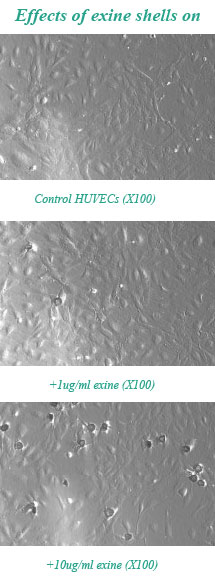Safety
The allergies associated with some pollens is entirely due to their protein content. The production of the exine shell removes or destroys all the proteins present and therefore any risk of an allergic reaction. Several tests were carried out to confirm this.
In order to assess the effects of the exines on cells, they were added in increasing concentration to growing human endothelial cells. Two types of cells were used, firstly human umbilical vein endothelial cells (HUVEC) which are endothelial cells extracted from the vein of an umbilical cord.
The second source of cells was the endothelial cell line EAhy 926. Proliferation, apoptosis and necrosis were assessed, together with direct microscopic examination. No difference in proliferation, apoptosis and necrosis were seen at any concentration used, suggesting that no direct toxic effect was present.
 The photomicrographs to the right of HUVEC cells treated with exine shells show that there was no evidence of any cellular damage.
The photomicrographs to the right of HUVEC cells treated with exine shells show that there was no evidence of any cellular damage.
In a further study, WST-1 assay was used to study the effects of exine shells on HUVECS growth (+/- SEM n=5). The addition of vehicle at the concentrations 100ng-10ug did not reduce proliferation of the HUVEC cells when compared to the untreated control.
Another independent study by A Maack, RTC GmbH, Schipperkamp 29, 31717 Nordsehl, Germany again failed to show that sporopollenin had any toxic effect. This group has developed soluble sporopollenin for skin treatment and other uses. For further details e-mail
The technology is based on pollen/spores, many types of which are consumed as part of people’s basic diets. It has in fact been sold as a health food supplement for at least the last 24 years (www.beepollensecrets.com) and can be consumed at levels as high as 35g per day (www.nutritional-supplements-health-guide.com).
Within food itself, one reference says that the number of pollen grains in honey depends on a number of factors, but can range from less than 20,000 to over 100,000 pollen grains per 10g of honey (Stanley, R.G. & Linskens, H.F. (1974) Pollen: Biology, Biochemistry and Management. Springer-Verlag Berlin, Heidelberg, Germany).
More recently Australian research on one type of honey showed the pollen content to vary between 0.15% and 0.44% by weight and quotes Canadian figures of 0.2% to 0.24% (Australian Government Report, How Much Canola Pollen is Present in Canola (Brassica Napus) Honey, RIIDC Publication No WO4/189, Dec 2004).
Other foods contain pollen from the plants from which they were produced, for example one study (http://www.burstscience.com/Studies/study82.php) showed that 70 particles of pollen were present in 1g of rye bread.
Any pollen that is consumed will be attacked by gut fluids and in vitro studies have indicated that empty pollen shells are then formed. The United States FDA have also stated that pollen particles can be regarded as GRAS.